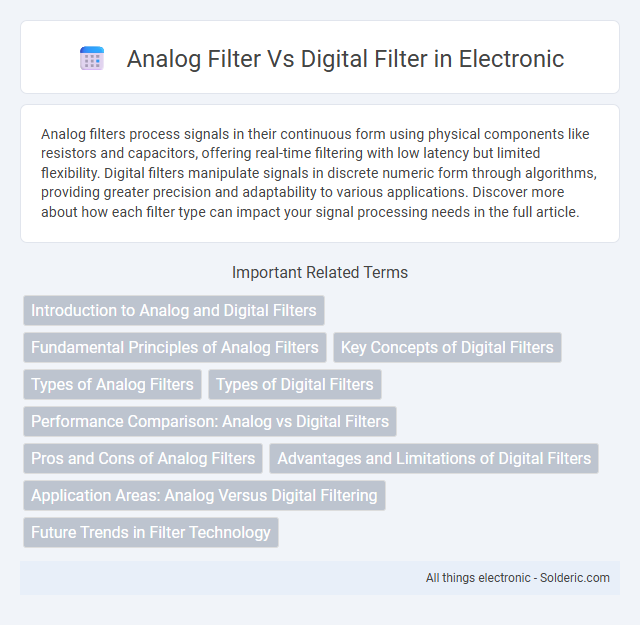Analog filters process signals in their continuous form using physical components like resistors and capacitors, offering real-time filtering with low latency but limited flexibility. Digital filters manipulate signals in discrete numeric form through algorithms, providing greater precision and adaptability to various applications. Discover more about how each filter type can impact your signal processing needs in the full article.
Comparison Table
| Feature | Analog Filter | Digital Filter |
|---|---|---|
| Implementation | Continuous-time electronic circuits | Discrete-time algorithms on digital processors |
| Signal Type | Analog signals | Digitized signals |
| Flexibility | Fixed, hardware-dependent | Highly flexible, reprogrammable |
| Precision | Limited by component tolerances | High precision, software-controlled |
| Noise Sensitivity | More sensitive to noise and component variations | Less sensitive due to digital processing |
| Complexity | Simple for low-order filters | Handles complex filter designs easily |
| Cost | Lower for simple filters | May be higher due to processing requirements |
| Delay | Minimal, real-time filtering | Processing delay due to computation |
| Power Consumption | Generally low | Varies, can be higher depending on processor |
| Application | Radio frequency, audio processing hardware | Software-defined radio, adaptive filtering |
Introduction to Analog and Digital Filters
Analog filters operate on continuous-time signals using electrical components like resistors, capacitors, and inductors, providing real-time signal processing with inherent physical limitations. Digital filters process discrete-time signals through algorithms implemented in software or hardware, offering higher precision, flexibility, and programmability for complex filtering tasks. Your choice between analog and digital filters depends on factors such as signal type, desired accuracy, and application requirements.
Fundamental Principles of Analog Filters
Analog filters operate based on continuous-time signals, utilizing electronic components like resistors, capacitors, and inductors to manipulate voltage and current for frequency selection. Their fundamental principles rely on the passive or active circuitry that shapes signal frequency responses through reactive elements and feedback mechanisms. Understanding these principles helps you design filters that provide real-time analog processing with minimal latency and power consumption.
Key Concepts of Digital Filters
Digital filters process signals using discrete-time algorithms, enabling precise control over frequency response and stability through techniques like finite impulse response (FIR) and infinite impulse response (IIR) designs. Unlike analog filters, digital filters offer programmability, repeatability, and the ability to implement complex filtering tasks such as adaptive filtering and noise reduction. Key concepts include quantization, sampling rate, and digital signal processing algorithms that optimize filter performance in various applications like audio processing and communications.
Types of Analog Filters
Analog filters include several types such as low-pass, high-pass, band-pass, and band-stop filters, each designed to selectively allow or block specific frequency ranges. These filters are typically implemented using passive components like resistors, capacitors, and inductors or active components like operational amplifiers. Common analog filter designs include Butterworth, Chebyshev, and Bessel filters, known for their distinctive frequency response characteristics and applications.
Types of Digital Filters
Digital filters primarily include Finite Impulse Response (FIR) and Infinite Impulse Response (IIR) types, each offering distinct advantages in stability and phase response. FIR filters are inherently stable and provide linear phase characteristics, making them ideal for applications requiring precise phase control. IIR filters, modeled after analog filters, are more computationally efficient but can introduce phase distortion and require careful design to maintain stability.
Performance Comparison: Analog vs Digital Filters
Analog filters provide continuous-time signal processing with low latency and minimal quantization noise, making them ideal for high-frequency or real-time applications. Digital filters offer superior flexibility, precision, and stability through programmable algorithms, enabling complex filtering tasks and adaptive tuning in your signal processing systems. The choice between analog and digital filters hinges on application-specific requirements such as bandwidth, noise tolerance, and implementation cost.
Pros and Cons of Analog Filters
Analog filters offer benefits such as simplicity, low latency, and excellent performance in high-frequency applications without the need for complex digital processing. However, they suffer from component tolerances, limited flexibility, and susceptibility to noise and signal degradation over time. Your choice should weigh these factors against the precision and adaptability advantages found in digital filters.
Advantages and Limitations of Digital Filters
Digital filters offer precise control over filter characteristics, enabling complex filtering operations such as adaptive filtering and linear phase response that are difficult to achieve with analog filters. They provide greater stability, repeatability, and immunity to component variations and noise, making them ideal for applications requiring high accuracy and programmability. However, digital filters require analog-to-digital conversion, introducing latency and computational complexity, which can limit their use in real-time or high-frequency analog signal processing scenarios.
Application Areas: Analog Versus Digital Filtering
Analog filters are widely used in real-time signal processing applications such as audio equipment, radio frequency circuits, and sensor signal conditioning where continuous-time processing is essential. Digital filters dominate in applications requiring high precision, adaptability, and complex algorithms like telecommunications, digital audio processing, and biomedical signal analysis. The choice between analog and digital filtering depends on factors such as signal bandwidth, noise tolerance, implementation cost, and required flexibility in filtering characteristics.
Future Trends in Filter Technology
Future trends in filter technology emphasize the growing adoption of digital filters due to their superior flexibility, precision, and integration with software-defined systems. Advances in machine learning algorithms enable adaptive digital filters that optimize performance in real time across various applications, from telecommunications to audio processing. Your choice between analog and digital filters will increasingly depend on the need for real-time adaptability and integration with evolving digital platforms.
analog filter vs digital filter Infographic

 solderic.com
solderic.com